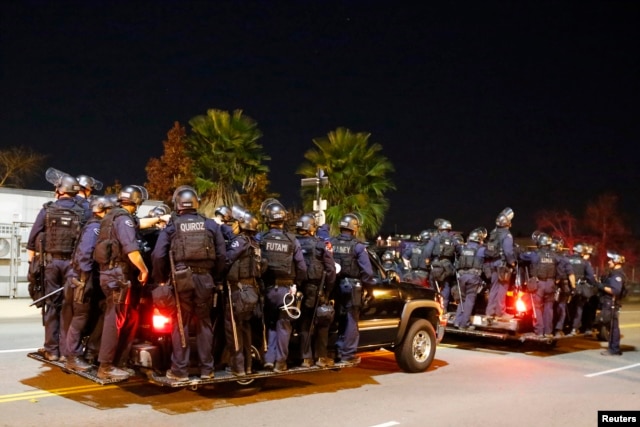
Los Angeles Police, Black Residents Say More Community Policing Needed
LOS ANGELES—
South Los Angeles is home to nearly a quarter of all residents of the second most populous U.S. city. It’s a group of mostly low-income neighborhoods covering more than 130 square kilometers, and has been the scene of violent gang activity many times.
When there is a shooting involving a Los Angeles police officer, it often takes place in South Los Angeles. But on summer nights, several times a week, there is a different kind of interaction between police and the residents.
As a part of a gang prevention program called Summer Night Lights, LAPD officers take part in community policing. They talk to residents, mainly black and Latino, and play with the youth. One of the officers at a recent session was Zadi Borquez.
«Being a role model to these kids out here in the park and hopefully doing my part in the community, that’s what I enjoy the most of being a police officer,” Borquez said.
While the children at Summer Night Lights play basketball happily with police officers, many African-Americans in the city and around the country are concerned that there have been too many recent cases of police brutality against people of color.
Police follow protesters during a march in Los Angeles, California, following Monday’s grand jury decision in the shooting of Michael Brown in Ferguson, Missouri, November 25, 2014.
Activists see ‘severe problem’
“Los Angeles, like pretty much every other police department in the nation, has a severe problem in the way in which [officers] treat all people, especially black people, poor people and people with mental-health challenges,” said Melina Abdullah, an organizer in Los Angeles for the Black Lives Matter Movement.
Members of that group have been staging a sit-in protest at city hall, demanding removal of Los Angeles’ police chief following the decision of a commission of inquiry that police did not violate their policies during a shooting last year in which a black woman was killed. Police said they acted because the woman had a knife.
“It’s about the system, so we have a systemic problem. We have a problem with policing in that they are actually trained to view us as enemy combatants, and so we need to transform that system,” Abdullah said.
Recent news about police shootings and shootings of police raised tensions between many African-American citizens and law-enforcement agencies.
History of racial tensions
Los Angeles is no stranger to racial tensions. The riots that followed the police beating of African-American Rodney King more than 20 years ago are still a vivid memory for many people, including Police Captain Andrew Neiman.
“I didn’t even want to be a police officer in L.A. following the riots. I felt that we had let down our community,» Neiman said. «It really touched me personally, because that was not the Los Angeles that I grew up with. But I’m glad I stayed. We took our lessons learned and we have really expanded that.»
However, the veteran police officer added, «We’re at a point right now where we’ve reached another crossroads in recognizing that we need to do more.»
Neiman contends smartphones and social media are fueling the current wave of racial tension: “Twitter, Facebook, Instagram, Vine. All of these social apps allow the public, general citizens, to take out their smartphones and capture video of a very dynamic situation, and instantly post it to the world without any context, without any understanding.”
Others say the new technology makes police more accountable.
‘Address community pain’
However, people on both sides of this argument say what is key is that perceptions need to change.
“We have to address the pain in the community,» said Skipp Townsend, a former gang member who is an intervention worker. «Stop labeling the community as violent, but address that pain and offer resources for people in pain.»
Townsend teaches life skills to ex-felons and people who are at risk. He says dialogue between police and members of the black community is necessary, and there also should be more community policing.
“There’s no way to build a relationship at the time of a crisis or incident, so [the police] should be proactive,” Townsend said.
Neiman agrees officers need to do more community policing, but he notes that resources are not unlimited.
Police resources limited
“LAPD, although we’re almost 10,000 strong, we can’t put 100 officers in every community,” the police captain said.
Melina Abdullah of Black Lives Matter says the problem also needs to be tackled as a social issue: “We want our funds to be used for things like living-wage jobs, like mental health resources, like after-school programs, like intervention and prevention work.”
In South Los Angeles, many of the residents don’t mind seeing more police at gang prevention events such as Summer Night Lights.
“We have good cops and we have our bad cops and, honestly, we only see our good cops come around the community where we have events like this frequently,” said Bobby Johnson, a local resident.
To break down perceptions, police and members of the African American community agree, building relationships is one step toward creating trust.


